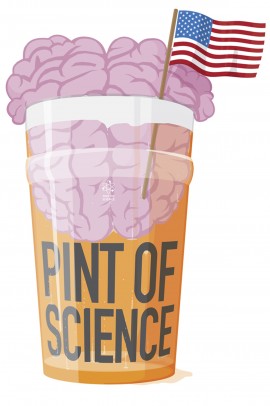Quaff a pint of science with UIC researchers this week
Pint of Science schedule
S. Jay Olshansky, “Can We All Live to 100?”
May 19, Beer Bistro North, 1415 W. Fullerton Ave.
Miiri Kotche, “MAD Lab, Crazy Good Science”
May 19, Prairie Moon, 1502 Sherman Ave., Evanston
Dirk Morr, “Lifting the Fog of Complexity”
May 19, Geek Bar, 1941 W. North Ave.
Thomas Park, “Blind, Naked and Feeling No Pain”
May 20, Geek Bar, 1941 W. North Ave.
Free; reserve online (although some events are labeled sold out, organizers say people without tickets will be admitted as capacity permits). Doors open 5:30 p.m., sessions start 6 p.m.
A scientist walks into a bar — and explains his or her research. That’s the idea for the Pint of Science Festival, held in nine major cities on Monday, Tuesday and Wednesday.
“Pint of Science brings everyday science to everyday people,” says Jillian Eskra, event coordinator and UIC representative for the series, as well as a Ph.D. candidate in pathology.
Four UIC researchers are participating this year at different locations, along with scientists from several other Chicago universities. Doors open at 5:30 p.m. Tickets are sold out for some events, but organizers say people without tickets will be admitted as space permits.
S. Jay Olshansky, professor of epidemiology and biostatistics, will speak on “Can We All Live to 100?” at Beer Bistro North, 1415 W. Fullerton Ave. Miiri Kotche, clinical associate professor of bioengineering, will discuss “MAD Lab, Crazy Good Science” at Prairie Moon, 1502 Sherman Ave., Evanston. Dirk Morr, professor of physics, will speak on “Lifting the Fog of Complexity” at Geek Bar, 1941 W. North Ave. The topic for Thomas Park, professor of neurobiology, is “Blind, Naked, and Feeling No Pain.”
Pint of Science was founded in 2012 by two scientists in London. Last year’s Chicago festival featured UIC physicist professor David Hofman and urban planning expert Moira Zellner.
Olshansky says the festival is a great opportunity for public engagement.
“A good part of the work I do is funded through the public and grants,” he says. “I think it’s appropriate to pay it back, and it’s really useful to interact with the general public on issues that are of interest and importance to them.”
Olshansky says he’ll present his research using available props.
“I’m going to get three glasses of different sizes representing the longevity of humans, dogs and mice — each one smaller than the next,” he says. “I’m going to illustrate by pouring beer into each of the glasses for how long we have lived in the past, how long we are living now and how much longer we might live in the future and what the consequences are if we continue to push out the envelope of survival.”
Listeners who answer his questions correctly get to drink the beer, he adds.
Kotche will discuss the “crazy good science” created by senior bioengineering students at UIC’s Innovation Center.
Park will describe his research with naked mole-rats, blind rodents that live successfully in conditions that would be toxic for other mammals. Understanding how the mole-rats have adapted to their environment could lead to new ways of pain relief in humans.
Morr hopes to help the audience understand the working of complex systems in nature. He will use color combinations to explain superconductivity, high-temperature superconductors, energy conservation and room-temperature superconductivity.
“Color scale is something that we’ve really used quite ubiquitously in the last couple of years to represent complex datasets and complex relationships,” he says.
And although he’s a native of Germany, he’s not a beer snob.
“American beers are good,” says Morr. “They’re very distinct from most brews that you can buy in Germany or France, but I like them.”

